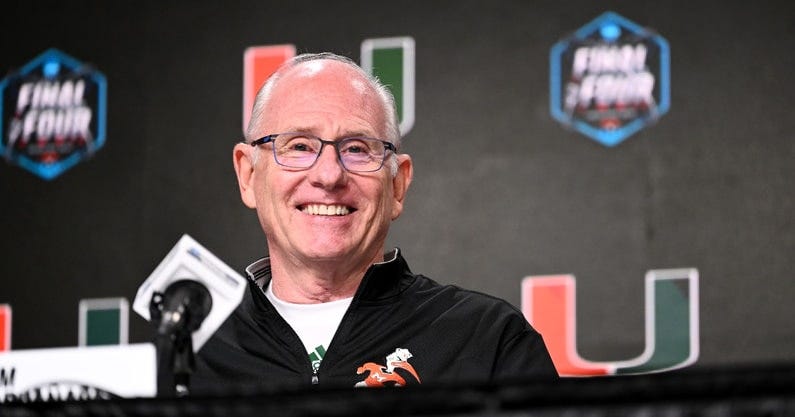Jim Larrañaga is a hilarious hypocrite
Also: Georgetown is back, Illinois is fun, and (many) other mailbag conclusions
Rick Pitino is 72 years old. Shortly after St. John’s win over Butler Saturday, he admitted he was having a hard time understanding the youths.
“Young people are different these days,” Pitino said. “I’m still struggling with it … I’m not quitting like some other coaches, but I’m struggling. I gave up drinking for New Year’s, but after today, I think I might have the shortest resolution in the history of mankind.”
Pointed, candid. Honest. Who can’t relate?
Imagine yourself as a highly successful (albeit notoriously self-destructive) 72-year-old man whose job is to teach to and connect with highly talented 18-to-22-year old people. Imagine the gaps you have to bridge.
We’re, personally, not even 40. Our daughter regularly calls us “sus.” The other day she was surprised by something and blurted out “breh.” Imagine being a grandfather, having zero context for this stuff, trying to go along. Imagine operating from a place of wanting the best basketball players you can get on your team, whatever that looks like, and it involves (openly) paying them money now, and managing their egos beyond their money, and the whole thing is intertwined and hard, and you’re 72, and they’re on apps, and what these kids are doing makes absolutely zero sense to you. You would struggle. You should. It’s OK to admit it.
You can be like Pitino, who wants to try to roll with it, or you can be Jim Larrañaga, who after a long and illustrious career — without putting too fine a point on it — dishonored himself last week.
Which brings us to our first mailbag question:
How did Jim Larrañaga's career crater so hard after that Final Four? Was it hypocrisy to blame players for transferring to seek NIL, considering he left George Mason for millions of dollars? — Brian Hare
It was the most obvious and most hilarious NIL/portal-related hypocrisy in the short but remarkable history of the genre.
Look: We can understand any coach being sort of blown away by the wild new world they have to recruit in. It’s a total shift from even five years ago, let alone 10, 15, 30. It’s hard for us, and we wholeheartedly support players being paid. It must be especially hard if you’ve been coaching ball since the early 1970s. College athletes have agents now. They will be paid by schools soon. This has all happened very fast. We get being freaked out.
We also get the Tony Bennetts of the world trying to run old school programs and deciding this isn’t what they signed up for. Fair enough. It isn’t. You can adapt or you can go. Your choice.
But Larrañaga’s midseason retirement was extremely funny (as is this news framing from The Athletic, which treats the whole thing as a sad story of a virtuous loss to a profession instead of a very rich man deciding he’s sick of other people trying to be as rich as him):
“What shocked me beyond belief was after we made it to the Final Four just 18 months ago, the very first time I met with the players, eight of them decided they were going to put their name in the portal and leave,” Larrañaga said.
“I said, ‘Don’t you like it here?’ (They said) ‘No, I love it. I love Miami. It’s great.’ But the opportunity to make money someplace else created a situation that you have to begin to ask yourself, as a coach, what is this all about? And the answer is, it’s become professional.”
Yeah, man. No shit. These guys are talented. They deserve to make money from their talent, possibly millions of dollars of money — the same millions of dollars of money you racked year after year after you left George Mason promptly in 2011. You’re not the only person who gets to make money anymore. Do you not see the issue here?
It’s one thing if you hated the system from the outset and more or less refused to participate in it (Bennett, again, comes to mind), but a fun add-on here is how Larrañaga massively profited from this system. Miami was the poster child for early NIL spending; jaws dropped at Kansas State transfer Nigel Pack getting $400,000 a year to leave Manhattan (Kan.) for Coral Gables. The horror! Miami was destroying the sport! John Ruiz, the CEO of LifeWallet, spent most of his time in the public eye bragging about how much money he was spending on Miami athletics, not just through traditional donations but openly negotiating player contracts on Twitter. Ruiz and Miami were the first NIL examples, to the point that Larrañaga was forced to spend most of his tournament press conferences defending the idea.
Those press conferences happened, by the way, because Miami went to an Elite Eight and Final Four in consecutive seasons due in no small part to Pack’s contributions — to say nothing of what the U’s well-documented boosters paid the rest of the team, chief among them Isaiah Wong.
Keep reading with a 7-day free trial
Subscribe to Buzzer by Eamonn Brennan to keep reading this post and get 7 days of free access to the full post archives.


